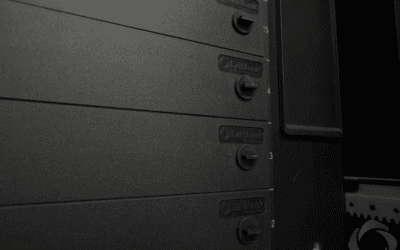What is Cold Aisle Containment
Cold aisle containment is a means of keeping a data center cool effectively. It is related to the popular hot aisle/cold aisle containment method but addresses many of the efficiency challenges this method faced when removing hot air from a data center.
But how does cold aisle containment work to remove exhaust air, and how can you cool a data center without a hot aisle ? In this guide, we cover how this system can enhance the cooling capacity of a data center.
In the article:
[—ATOC—]
[—TAG:h2—]
How Does a Cold Aisle Containment System Work?
The purpose of any system that uses cold aisles is to provide cold supply air that circulates and keeps IT equipment cool. This is traditionally distributed from beneath a raised floor system using perforated floor tiles to provide circulation – this is known as the air plenum. As this circulation cools hot equipment, exhaust air is extracted from the data center.
The goal is to maximize the efficiency of removing hot air and introducing cold supply air while maintaining a consistent temperature throughout the entire room. Keeping a computer room at a controlled temperature is vital in the data center industry, as higher temperatures can lead to:
- Computer equipment operating slowly
- Permanent damage from regular overheating
- High energy costs
Cold aisle data center containment was introduced as a way to provide a consistent supply temperature and lower cooling costs across the industry. So what’s the difference between the old and new systems?
What is the Difference Between Hot Aisle and Cold Aisle Containment?
The main difference between hot aisle containment options vs cold aisle containment is that using the latter method, cooling infrastructure is protected from recirculating exhaust air. So how is this achieved?
Hot Aisle Containment
These systems use the same principle of distributing air from beneath a raised floor and removing heat by directing it to the AC coil, usually through a drop ceiling void. However, there is no physical barrier between the cold section and the rest of the data center room using a hot aisle system: instead, it relies on the natural properties of warm air rising to ensure that cool air isn’t being returned to the AC.
A consistent issue with this method is that cold air intakes facing hot exhaust air meant that it is an inefficient means of managing air flow. There is insufficient separation between the server racks in data centers and the cooling unit, which can lead to hot spots and risk computing equipment overheating.
Cold Aisle Containment
A cold aisle containment system uses containment panels to separate the cooling system from the computer room. This separate area can be accessed through doors at the ends of the aisle. By separating the cooling equipment from the room containing other computing equipment, intake of cold air can be provided without the risk of it mixing with warmer exhaust.
Cooling is distributed directly at the server intake, where it is needed most. This provides better protection to IT equipment and creates efficient operating conditions for the AC. This in turn can lead to energy savings.
Benefits of Moving on From Mixing Hot and Cold Air
Hot aisle containment has been a popular solution with data center professionals for years. Many existing data centers are designed with this type of containment system: the perceived elegance of letting thermodynamics separate the hot and cold air is appealing. Furthermore, changing the layout/design of data centers can seem like a daunting task.
Below are some of the benefits that explain why cold aisle containment is the latest news in data center containment systems.
Efficient Airflow Management
With the cooling system encased within storage cabinets, cool air can be distributed through a raised floor as usual but sent into the computer room only where it is needed and where it will be of the greatest benefit. This allows for more direct cooling of equipment compared with hot aisle containment and increased cooling capacity.
Hot air is returned directly to the air handlers and there’s no risk of mixing.
Air Handler Efficiency
Many sites find that their energy bills are running high because the heat and cold mix at the containment aisle ends and stop the air handler from doing its job properly. A cold area that is properly separated using blanking panels can help conserve energy and increase cooling capacity significantly.
The aisle uses a raised floor and can still be accessed through doors for maintenance. Protecting the containment area with walls and doors not only promotes energy efficiency but is an excellent fire suppression method, as cooling equipment is separated from the rest of the computer equipment.
Supporting High-Density Installations
Higher-density systems can receive targeted cooling through this method. By eliminating the risk of mixing, high-density installations can be fed an appropriate level of cool air. Containment systems for high-density server cabinets often struggle to provide an adequate level of cooling because they attempt to chill an entire room rather than a targeted area.
FAQ
Why is aisle containment hot?
Servers and computer systems give out a huge amount of heat. This heat needs somewhere to go or the equipment is at risk of damage. These systems are supposed to remove warm air to an AC coil that processes the air and cools it before it is ready to be redistributed. A hot aisle was where the warmer air gathered, while a cold aisle was a section of raised floor where cooler air was distributed.
What are the benefits of containment?
Containment is designed to protect valuable equipment and minimize the operational costs of a data center. It uses thermodynamics and in some cases enforced barriers to draw heat away from computer equipment and distribute cool air where it’s needed most.
Using Cold Aisle Containment Systems in a Data Center
This type of containment system opens doors to lower energy costs by installing walls where they’re needed most. Cold aisle containment is changing the way data centers manage their equipment and their energy bills across the U.S.
Read more articles here today and be sure to view data center cooling and equipment.



